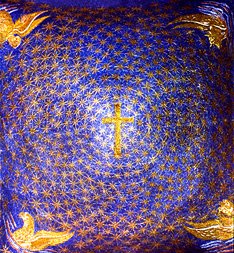
if I had ever learned to take notes. A few years ago, I got obsessed with trying to connect Ruskin to the art of Byzantine mosaic (especially the mosaics in Ravenna, which Pound was so crazy about). I had in my head his splendid idea of purchasing selected mosaic tiles from the Vatica fabbrica – which had at least 25,000 different colors available – & having them installed in color-gradient friezes in British art museums for the edification of British artists.
But I couldn't find a bit of documentation for that: not in the dozens of Ruskin volumes kicking around the house, nor in the various biographies and critical studies I owned. So tantalizing – to connect JR to the art which was so crucial to parts of high modernism (EP, Yeats), & which perhaps even provides an analogue for LZ.
I was of course misremembering. The man with the mosaic idea was Darwin's cousin the eugenicist Sir Francis Galton (1822-1911), as quoted in AS Byatt's The Biographer's Tale (2001). In Galton's own words:
In the Fabbrica of mosaics at the Vatican in Rome there are no less that 25000 trays or bins, numbered consecutively, and each filled with cakes of mosaic material, each separate bin being devoted to a different colour…It might well be a subject for the subsequent consideration of the authorities of South Kensington whether they should not select by means of the large amount of skill and science at their disposal say one tenth of the Vatican’s series to create what might be called a South Kensington scale of colours and distribute identical copies of it in mosaic, which would occupy a space according to the above…among the art schools of the United KingdomSimilarly, my last post misremembers what John Latta wrote, or rather rewrites him, drawing upon something else I was reading about the same time. Samuel Delany writes in the essay "Shadow and Ash":
The discursive model through which we perceive the characteristic works of High Modernism – from The Waste Land and Ulysses to The Cantos and Zukofsky's "A" and H.D.'s Helen in Egypt, from David Jones's In Parenthesis and The Anathemata to Charles Olson's Maximus Poems and Robert Duncan's The Structure of Rime and Passages – is that of a foreground work of more or less surface incoherence – narrative, rhetorical, and thematic – behind which stands a huge, and hugely unified, background armamentarium of esoteric historical and esthetic knowledge, which the text connects with through a series of allusions and relations that organize that armamentarium as well as give it its unity.That's nothing at all like what John said; nor is it anything much like what I attributed to him – "High Modernist monumentality sneak[ing] into the post-avant woodpile." But the latter idea, which is something that bears thinking about, seems to me a fusion in my own disordered mind of John's kvetching about "projects" & Chip's large diagnosis of a "post-Modernist" reading experience.
The educated reading such texts request is always a virtual one. Even somebody who is richly familiar with the commentaries and who has studied both sources and text can only hold onto fragments of both background and foreground, and then only for a more or less limited time.
What has happened, of course, is that eventually poets – if not other readers as well – have noted that, with or without access to the background armamentarium, there is nevertheless an experience of reading these texts. [I argued something similar in LZ & the Poetry of Knowledge.] And numerous poets of the last forty years – in not, indeed, the last hundred – have tried to estheticize this affect directly.
A (Stephen) Dedalian danger, my friends, the curse of "Reading two pages apiece of seven books every night, eh?"*
*Ulysses, Chapter 3 ("Proteus"), followed shortly by this striking forecast of LZ: "Books you were going to write with letters for titles. Have you read his F? O yes, but I prefer Q. Yes, but W is wonderful. O Yes, W."
No comments:
Post a Comment